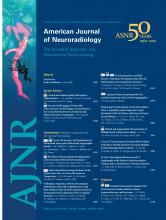Abstract
SUMMARY: Neuroferritinopathy is an autosomal dominant extrapyramidal movement disorder, caused by FTL gene mutations. Iron decreases the MR T2* decay time, therefore increasing the R2* (R2* = 1 /T2*), which correlates with brain tissue iron content. 3T structural and quantitative MR imaging assessment of R2* in 10 patients with neuroferritinopathy demonstrated a unique pattern of basal ganglia cavitation involving the substantia nigra in older patients and increasing thalamic R2* signal intensity detectable during 6 months. Increasing R2* signal intensity in the thalamus correlated with progression on a clinical rating scale measuring dystonia severity. Thalamic R2* signal intensity is a clinically useful method of objectively tracking disease progression in this form of neurodegeneration with brain iron accumulation.
ABBREVIATIONS:
- FTL
- ferritin, light polypeptide
- HDRS
- Huntington's Disease Rating Scale
- NBIA
- neurodegenerative disorders with brain iron accumulation
- PKAN
- pantothenate kinase–associated neurodegeneration
- PLAN
- PLA2G6-associated neurodegeneration
- R2
- T2 relaxation rate
- R2*
- T2* relaxation rate
- UDRS
- Unified Dystonia Rating Scale
- UHDRS
- Unified Huntington's Disease Rating Scale
- © 2012 by American Journal of Neuroradiology












